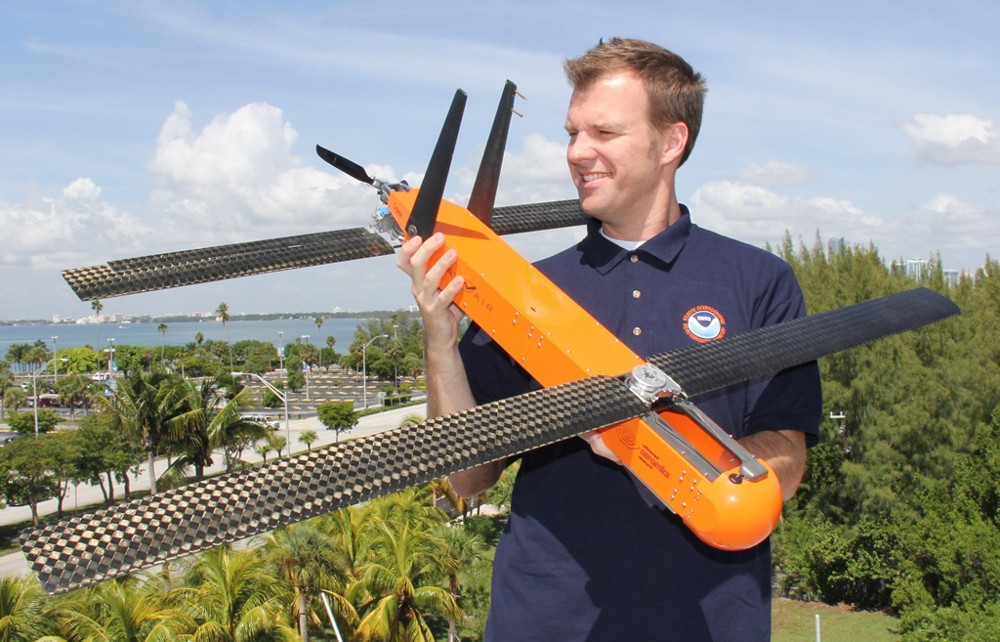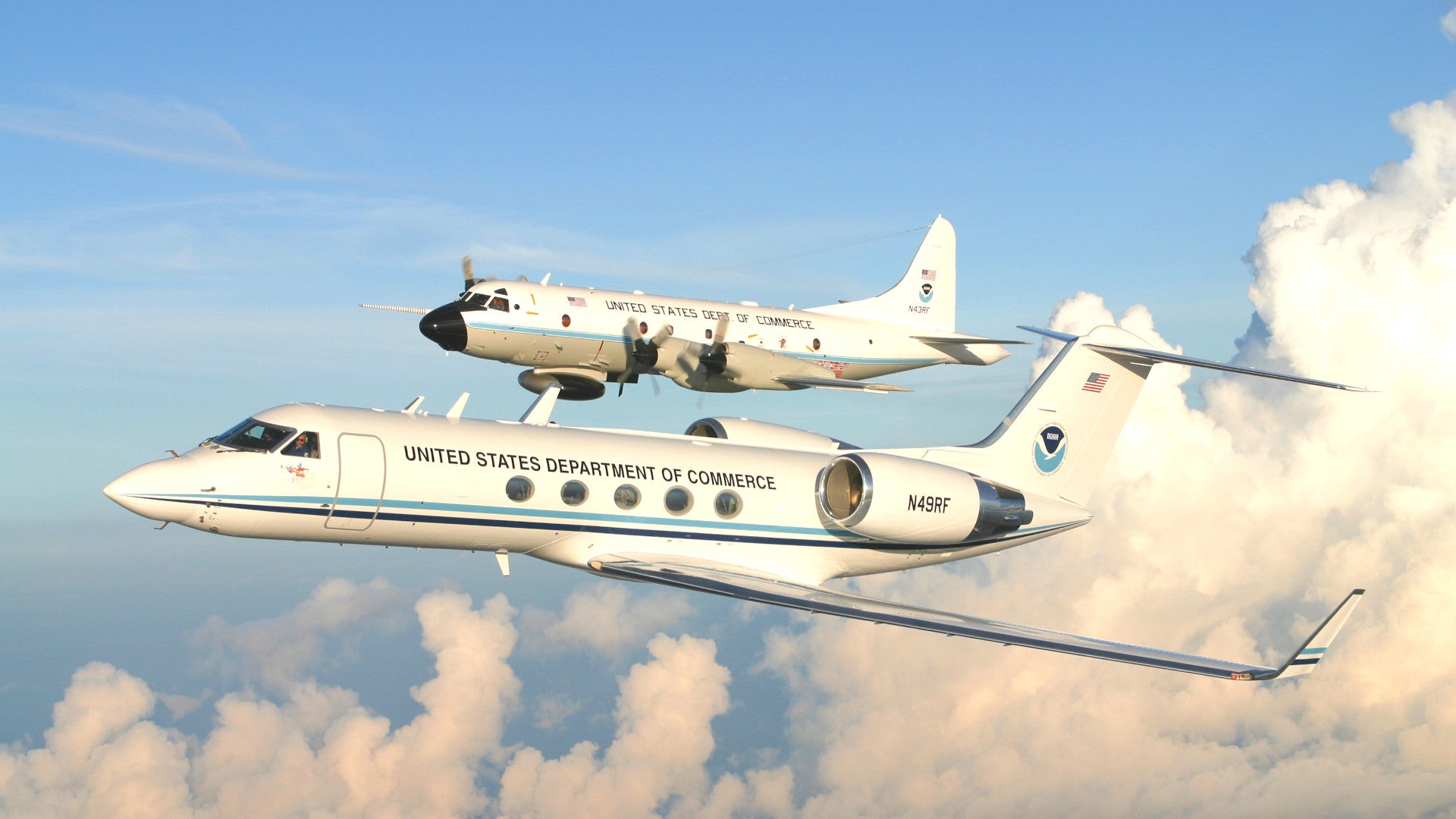In the aftermath of Hurricane Sandy, the U.S. National Oceanic and Atmospheric Administration (NOAA) began a unique program to more closely study these devastating tropical storms and their impacts using small, expendable drones called Coyotes. But despite the system proving its worth as recently as the monitoring of Hurricane Maria, the project is now effectively dead amid a funding crisis that has begun to threaten the agency’s aerial research efforts in general, including leaving one of its research planes, a modified Gulfstream IV-SP business jet, increasingly dangerous to fly.
On Sept. 24, 2017, one of NOAA’s two WP-3D Orion weather research aircraft, nicknamed Kermit after the Muppets character, flew out toward Hurricane Maria to collect data on air pressure, moisture, temperature, and wind speed and direction via its on board Doppler Lidar laser sensor and the remote controlled Coyotes. This flight to inspect the deadly storm, along with others earlier in September 2017, would use up all but one of the Hurricane Research Division’s drones.
“I’ve got nothing left in the bank,” Dr. Joe Cione, head of NOAA’s Coyote program, told Popular Mechanics. “Just one Coyote.”
That the research-focused agency came to be one of the primary customers for Raytheon’s tube-launched lightweight drone in the first place was something of a fluke. After Hurricane Sandy slammed into the northeastern United States in October 2012, doing significant damage to New York and New Jersey, Congress approved $61 billion for disaster relief and related efforts as part of the Disaster Relief Appropriations Act of 2013.

As part of a larger pool of money legislators approved for elements of the Department of Commerce, NOAA specifically received $140 million, less the $290 million in earlier versions of the bill, but still a not insignificant amount for an agency that has an average annual budget of less than $6 billion. $25 million of this was specifically set aside for investment in ways to “improve weather forecasting and hurricane intensity forecasting capabilities.”
Coyote was one program to come out of that new budget. It’s been hard to sustain that funding with the agency’s budget remaining relatively level in the years since Sandy. The U.S. Navy, which has been testing Coyote as part of its own research into the emerging capabilities of drone swarms, managed to get some funding over to NOAA, ostensibly because it has its own vested interest in understanding the impacts and effects of tropical storms.
“I feel this is where hurricane research needs to go,” Cione added to Popular Mechanics. “But we have no resources for more.”
The Raytheon-made drone is relatively cheap at approximately $15,000 per unit, but those costs could easily add up for a small organization like NOAA. That NOAA generally doesn’t expect the small unmanned aircraft, weighing just seven pounds, to survive their trip into a hurricane’s eyewall, the most intense part of the storm, doesn’t help matters.
But that also means they can go where other aircraft, manned or not, can’t and gather vital data that would otherwise be unavailable to scientists. In various interviews since 2014, Cione has made it clear that he feels Coyote has greatly expanded the capacity of NOAA’s hurricane researchers.

“The Coyote can make S turns, going with the wind, hunting MaxV [maximum velocity],” he explained to Popular Mechanics. “It’s an MRI instead of a single point snapshot.”
Otherwise the WP-3Ds have to drop unguided sensor pods, known as dropsondes, from a safe position and hope they’ll glide into the right parts of the storm. A Cione noted, they can only send information back for a short period. Coyotes can fly more than 50 miles away from the controlling aircraft for at least an hour.
The lack of money for the Coyote program is indicative of larger problems emerging at NOAA. On Sept. 27, 2017, The Washington Post reported that the agency’s lone Gulfstream IV-SP research plane, nicknamed Gonzo after another one of the Muppets, had aborted three missions in eight days due to technical problems.

NOAA purchased the plane in 1996 to perform high altitude research that the WP-3Ds, which fly routes cutting through the storms, simply can’t provide. Cruising at an altitude of around 45,000 feet, Gonzo can release its dropsondes across wide areas in the upper atmosphere, as well as gather data with its doppler radar system. By flying over developing tropical storms rather than slicing through them, the aircraft provides a unique picture of the weather system below, improving forecasting about where it might travel.
In recent years, though, budget cuts and shortfalls have made harder for the agency to maintain the aircraft properly. Especially worrisome, the seal on the plane’s main cabin door failed during a flight on Sept. 25, 2017, depressurizing the aircraft and forcing the crew to use the emergency oxygen system as they returned to the Aircraft Operations Center at Lakeland Linder Regional Airport in Lakeland, Florida. With no other high altitude aircraft and only three planes in total in the entire NOAA hurricane hunting fleet, there was no backup available to take over in any way.
Despite being required to by a law President Donald Trump signed in April 2017, “NOAA has taken no major steps to acquire reliable backup,” Senator Bill Nelson, a Florida Democrat and the bill’s sponsor, complained to Benjamin Friedman, NOAA’s acting administrator, in a letter earlier in September 2017, which The Post obtained. “It is unacceptable that we again find ourselves in the midst of hurricane season without reliable NOAA aircraft reconnaissance and without backup capability.”

It’s unclear what, if anything, Friedman can realistically do about the situation. The U.S. government at present is only at work for the time being thanks to the latest in a long series of temporary spending measures, known as continuing resolutions, rather than a full budget.
In its most recent budget request for the 2018 fiscal year, the agency asked for nearly $4.8 billion, a cut of almost $1 billion or one fifth from what it said it need in the previous fiscal cycle. This was part of a 16 percent cut across Commerce in President Trump’s first budget proposal.
NOAA has tried to make up the shortfall by making arrangements with other public and private organizations. In 2016, the University Corporation for Atmospheric Research temporarily made its Gulfstream V available to the agency for a series of flights in the Pacific Ocean.

More recently, in August 2017, NOAA’s hurricane researchers team up with NASA to make use of that agency’s Global Hawk drone, configuring it to employ dropsondes. This month-long project consisted of six 24-hour missions in the Pacific and Atlantic Oceans and the Gulf of Mexico.
These projects have been ad hoc and rely entirely on the availability of another party’s aircraft, though. None of the deals provides a back up option for Gonzo that is ready to go whenever NOAA needs it or offers a way to replace the precision capabilities of the Coyote drones.
NOAA needs to be “diligent in complying with the law,” Senator Nelson said in his letter to the agency’s acting head, according to The Post. “Truly lives and property depend on it.”

Nelson isn’t being hyperbolic. Hurricane research only looks set to become increasingly important. Global climate change means warmers seas to feed storms as they build in the Atlantic and Pacific. It was quite possibly a contributing factor to the appearance of two “once in 500 years” storms, Harvey and Irma, back-to-back during the 2017 hurricane season.
Harvey killed more than 70 people in Texas alone. Irma killed more than 120 across the Caribbean. Now Maria has claimed almost 70 more already, as of Oct 1, 2017. Being able to adequately understand how these storms work is essential to accurately predicting their immediate movements and impacts and preparing for future storms, as well as long-term predictions about hurricane frequency and size.
If the 2017 hurricane season has been any indication, NOAA needs all the funding it can get to increase its ability to reliable study these storms. Gonzo’s dropsonde operations alone have been enough to improve the accuracy of its tracking forecasts by 20 percent, according to NOAA’s website. Cuts to its already meager offer a minimal savings for the overall federal budget compared to the benefits of having the agency operating at full capacity.
Unfortunately, without a new source of funding, the agency will likely have to continue relying on Gonzo, its one remaining Coyote, the charity of other organizations, and its own ingenuity to keep doing its vital work.
Contact the author: joe@thedrive.com
